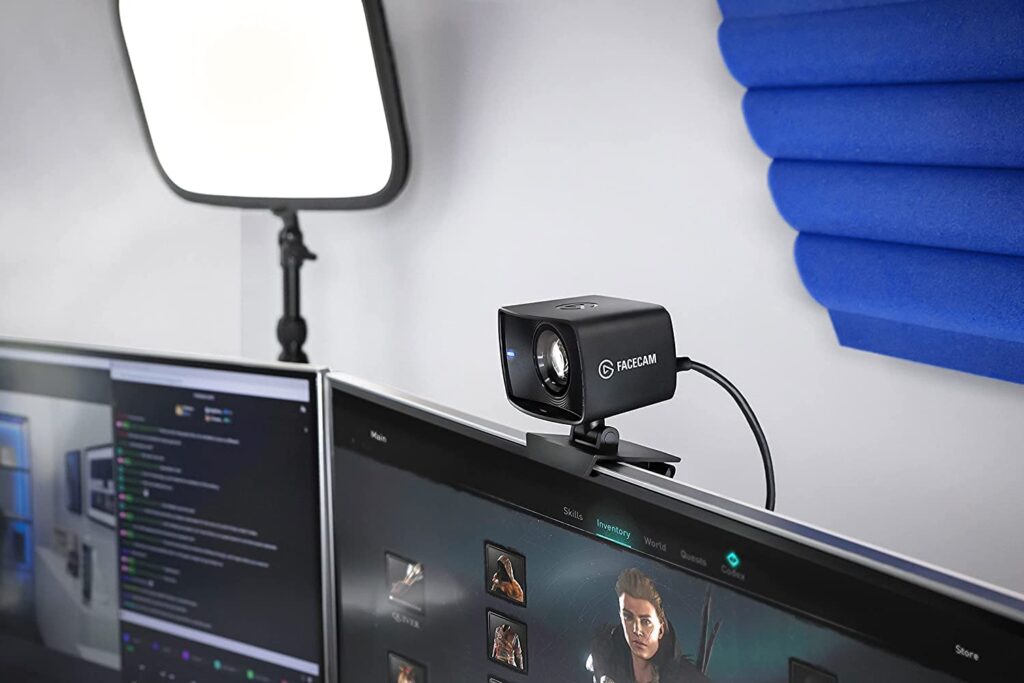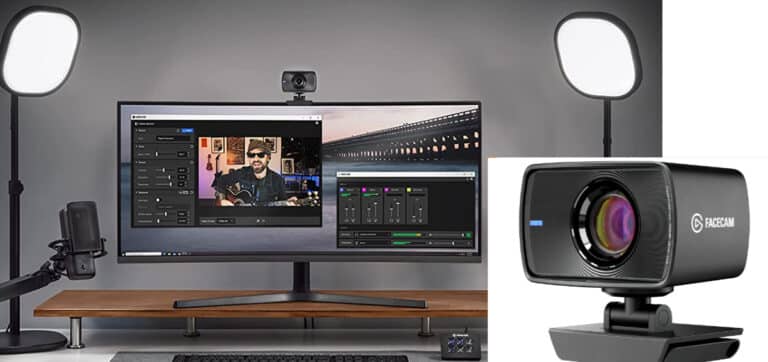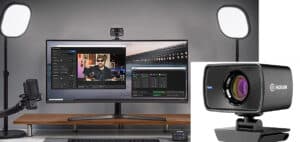Elgato is best known for its stream decks & capture cards, but after releasing its Wave line of microphones last year, the company is now expanding into the streamed hardware arena with the Elgato Facecam. As the name suggests, this is a camera that aspires to be the greatest webcam for livestreaming. It has 1080p At 60 fps filming, as well as unusual features including a fixed focus 24mm lens or an app that gives you your ISO levels while streaming. However, with that audience specialization comes a lack of capabilities such as HDR or 4K, which streamers choose to disregard anyhow because platforms like Twitch do not support them.
What will you see here?
Design and build

The Facecam is a somewhat hefty, rectangular black box with a deep, curved depression on the front panel that houses the 24mm f/2.4 lens. On the left side of this recess, a blue indicator LED rests, and notches on the top and bottom borders hold detachable, lens-cap-like privacy covering that clicks into place. A USB-C connector is included on the rear panel for attaching to your computer. The USB A-to-C cable provided is four feet long.
The camera may be attached to any standard tripod or the accompanying monitor clip via a screw attachment on the bottom. The clip features a traditional hinge-and-lip construction that braces against the top edge and rear of your laptop screen, allowing it to hold pretty firmly in place. A tiny joint on the clip’s top surface allows you to tilt your camera up and down, and a movable disc just on the screw attachment itself allows for left-right rotation.
Features of the Elgato Facecam

If the name doesn’t give it away, the Elgato Facecam is all about fidelity and livestreaming. To that purpose, it provides 1080p At 60 fps recording as well as a light, if somewhat unstable, software suite for customizing your camera’s output. Aside from that, you don’t get HDR or 4K, but the camera does feature flash memory, which allows it to carry 1 profile’s worth of your preferred settings onboard. It also lacks autofocus, opting instead for a fixed focus lens tuned to clearly show subjects within 3 to 5 yards of the device.
The Camera Hub software on the Elgato Facecam essentially acts as a set of sliders that you can use to change magnification, contrast, exposure, white balance, as well as other parameters. That’s not an unusual configuration, but there’s not a great deal of information on what all of these variables signify. The target audience for this camera should already be familiar with most of that. But after viewing the user-friendly but nevertheless powerful Dell Ultrasharp Webcam software, this feels like a step back. The program also lacks any preset options like “vivid” or “warm,” which are prevalent on some other cameras and may make it more consumer.
The ISO box is noteworthy because it constantly updates using new information to assist you to fine-tune your white balance to your illumination. It’s another advanced function, but it does make manually tweaking the image to match your shooting location a little simpler.
Manual Exposure Controls of the Elgato Facecam

The Elgato Video Hub software provides remarkably fine-grained control over the Facecam. There are standard image changes accessible, such as field of view adjustment, contrast/saturation/sharpness slider, and anti-flicker. The main surprise is in the Exposure area, where you may choose between center-weighted & frame-average automated exposure by default. Unchecking the Automatic preset gives you complete shutter and ISO exposure settings. Also allows you to choose how the camera shoots you depending on the lighting.
While either automatic temperature option is adequate, the ability to adjust exposure like a conventional camera is useful. With a color range of temperature of 2,800K to 12,500K, white balance additionally provides automated and exact adjustments.
BYO Mic:

The Elgato Facecam, like the Dell UltraSharp Webcam, lacks a microphone. This makes sense, at least for prospective streamers and anyone concerned about clear audio. Even the best webcams don’t sound as nice as a USB microphone and headset boom mic. Which using with any camera, especially for filming and broadcasting. It’s still a notable absence for a webcam that costly, especially given it lacks the UltraSharp’s 4K resolution.
How good is Elgato Facecam?
Much of what makes it unique is due to the software, but not completely, and, as with any camera, superb image quality begins with the lens & sensor. The Facecam can capture in 1080p at 60 frames per second. On recordings, it produces a sharp, detailed image with smooth natural movement.
Does Elgato Facecam have a microphone?
No, the Elgato Facecam lacks a microphone. Typically, built-in microphones on webcams do not provide high-quality sound. If you need a high-quality microphone to combine with your Facecam, consider Wave:3. If you need a USB microphone, and Wave XLR if you need an XLR microphone.
Why is Elgato Facecam grainy?
The camera’s autoexposure generally sets the ISO sensitivity fairly high, about ISO 1200 to 1500 in a well-lit area and more than twice that in a dark room. Also both of which are unusually high settings for its sensor. As a result, the image it records might become quite noisy and grainy.
Conclusion
Elgato is widely renowned for building devices with streamers and video makers in mind, thus the lack of a dedicated camera has long seemed odd. The Elgato Facecam, an full HD 1080p camera that stands between the Epocam phone app and the Cam Link 4K, has finally filled that need.
Read more
- The Best Webcams For Streaming And Work From Home In 2022.
- Get Best Capture Cards for your Nintendo Switch!
- Install Windows 10 on your Mac through Boot Camp now!
- How you can adjust light and colour in the Photos app for iPhone and iPad!
- Best manual camera apps for iPhone- Show your photography skills!
















